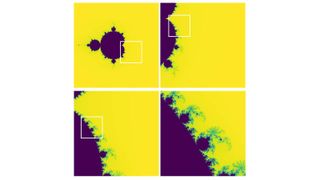Is the human mind made of fractals?
Our thoughts might have their own form of geometry

The biological nature of human thought is one of the brain's greatest secrets, especially as our thinking climbs into higher levels of abstraction, but according to a newly published study, we might at least be able to see the outlines of what it looks like and it's surprisingly familiar.
The paper, published today in the journal Nature Communications, comes from a research team at Dartmouth who approached the intricate network of human neurons from which thought arises as analogous to the mathematical idea of a fractal: a geometric shape that looks similar no matter how you scale it.
"To generate our thoughts, our brains create this amazing lightning storm of connection patterns,” said Jeremy R. Manning, an assistant professor of psychological and brain sciences, director of the Contextual Dynamics Lab at Dartmouth, and the paper's senior author. “The patterns look beautiful, but they are also incredibly complicated. Our mathematical framework lets us quantify how those patterns relate at different scales, and how they change over time."
Similar to the way that fractal geometry repeats its patterns in an infinite progression, the study reveals that our brains operate in a similar manner by having its patterns of interactions reflected at varying scales. According to the paper, when people engage in more complex thinking, their brain networks organize into a fractal like pattern, but when our thinking is disrupted in some way, those patterns lose their integrity and start to break down.
- Samsung is building a memory chip that mimics the human brain
- Have our brains just not evolved for social media?
- The world’s largest chip is creating AI networks larger than the human brain
To show this, researchers had participants listen to a short story and observed the communication patterns between different parts of the brain. Using their fractal inspired framework, they were then able to distinguish different "orders" of a pattern, so when no pattern was present, the participants were said to have a "zero-order" pattern.
When a pair of brain structures interacted, that was said to be a "first-order" pattern, and higher order patterns grew out of even more brain structures interacting with each other.
When participants listened to the 10-minute-long story, fourth-order patterns emerged spontaneously in their neuro-networks. Then, the researchers started shuffling up the story being played, first by shifting around paragraphs into different sequences so that some of the story's meaning could be understood. This dropped the participants brain networks down to a second-order pattern.
Get daily insight, inspiration and deals in your inbox
Sign up for breaking news, reviews, opinion, top tech deals, and more.
When every word in the story was shuffled, all meaning was lost and the participants registered a zero-order pattern.
"The more finely the story was shuffled, the more the fractal structures of the network patterns were disrupted,” said Lucy Owen, a psychological and brain sciences graduate student at Dartmouth and first author of the paper. “Since the disruptions in those fractal patterns seemed directly linked with how well people could make sense of the story, this finding may provide clues about how our brain structures work together to understand what is happening in the narrative.”
Analysis: how much can we ever really know about what happens in the mind?

Exploring the nature of the human mind was pretty much the first hard question we humans ever put to ourselves, and after creating several disciplines from philosophy to psychology to neuroscience specifically to figure out what's going on in our heads over the last few thousand years, we have made remarkably little progress relative to other pursuits.
Part of it might just be the inherent complexity of the human brain, with its 100s of billions of neurons and 100s of trillions of individual neural connections. Probing those connections was always going to be an impossible task, but it is amazing how much we still don't know about something as simple as what is actually going on when you think a thought.
Forget art, what does it mean to realize that you want pizza instead of sushi? Maybe we'll learn more as the century progresses and quantum computing starts to flex its qubits, but I'm skeptical. I think there are just things that will be beyond our reach and I can imagine us traveling through space sooner than I can see us having a clear insight into the workings of our own minds.

John (He/Him) is the Components Editor here at TechRadar and he is also a programmer, gamer, activist, and Brooklyn College alum currently living in Brooklyn, NY.
Named by the CTA as a CES 2020 Media Trailblazer for his science and technology reporting, John specializes in all areas of computer science, including industry news, hardware reviews, PC gaming, as well as general science writing and the social impact of the tech industry.
You can find him online on Bluesky @johnloeffler.bsky.social
Most Popular


